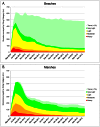Extent and degree of shoreline oiling: Deepwater Horizon oil spill, Gulf of Mexico, USA
- PMID: 23776444
- PMCID: PMC3680451
- DOI: 10.1371/journal.pone.0065087
Extent and degree of shoreline oiling: Deepwater Horizon oil spill, Gulf of Mexico, USA
Abstract
The oil from the 2010 Deepwater Horizon spill in the Gulf of Mexico was documented by shoreline assessment teams as stranding on 1,773 km of shoreline. Beaches comprised 50.8%, marshes 44.9%, and other shoreline types 4.3% of the oiled shoreline. Shoreline cleanup activities were authorized on 660 km, or 73.3% of oiled beaches and up to 71 km, or 8.9% of oiled marshes and associated habitats. One year after the spill began, oil remained on 847 km; two years later, oil remained on 687 km, though at much lesser degrees of oiling. For example, shorelines characterized as heavily oiled went from a maximum of 360 km, to 22.4 km one year later, and to 6.4 km two years later. Shoreline cleanup has been conducted to meet habitat-specific cleanup endpoints and will continue until all oiled shoreline segments meet endpoints. The entire shoreline cleanup program has been managed under the Shoreline Cleanup Assessment Technique (SCAT) Program, which is a systematic, objective, and inclusive process to collect data on shoreline oiling conditions and support decision making on appropriate cleanup methods and endpoints. It was a particularly valuable and effective process during such a complex spill.
Conflict of interest statement
Figures




Similar articles
-
Response of salt marshes to oiling from the Deepwater Horizon spill: Implications for plant growth, soil surface-erosion, and shoreline stability.Sci Total Environ. 2016 Jul 1;557-558:369-77. doi: 10.1016/j.scitotenv.2016.03.049. Epub 2016 Mar 24. Sci Total Environ. 2016. PMID: 27016685
-
Shoreline oiling from the Deepwater Horizon oil spill.Mar Pollut Bull. 2016 Jun 15;107(1):170-178. doi: 10.1016/j.marpolbul.2016.04.003. Epub 2016 Apr 18. Mar Pollut Bull. 2016. PMID: 27098990
-
Heavily Oiled Salt Marsh following the Deepwater Horizon Oil Spill, Ecological Comparisons of Shoreline Cleanup Treatments and Recovery.PLoS One. 2015 Jul 22;10(7):e0132324. doi: 10.1371/journal.pone.0132324. eCollection 2015. PLoS One. 2015. PMID: 26200349 Free PMC article.
-
A review of Gulf of Mexico coastal marsh erosion studies following the 2010 Deepwater Horizon oil spill and comparison to over 4 years of shoreline loss data from Fall 2010 to Summer 2015.Mar Pollut Bull. 2021 Mar;164:111983. doi: 10.1016/j.marpolbul.2021.111983. Epub 2021 Jan 26. Mar Pollut Bull. 2021. PMID: 33513545 Review.
-
Environmental effects of the Deepwater Horizon oil spill: A review.Mar Pollut Bull. 2016 Sep 15;110(1):28-51. doi: 10.1016/j.marpolbul.2016.06.027. Epub 2016 Jun 11. Mar Pollut Bull. 2016. PMID: 27301686 Review.
Cited by
-
Evaluation of Blue Crab, Callinectes sapidus, Megalopal Settlement and Condition during the Deepwater Horizon Oil Spill.PLoS One. 2015 Aug 13;10(8):e0135791. doi: 10.1371/journal.pone.0135791. eCollection 2015. PLoS One. 2015. PMID: 26270970 Free PMC article.
-
High Arctic seawater and coastal soil microbiome co-occurrence and composition structure and their potential hydrocarbon biodegradation.ISME Commun. 2024 Jul 16;4(1):ycae100. doi: 10.1093/ismeco/ycae100. eCollection 2024 Jan. ISME Commun. 2024. PMID: 39101031 Free PMC article.
-
Oiling of American white pelicans, common loons, and northern gannets in the winter following the Deepwater Horizon (MC252) oil spill.Environ Monit Assess. 2020 Mar 17;191(Suppl 4):817. doi: 10.1007/s10661-019-7925-y. Environ Monit Assess. 2020. PMID: 32185520 Free PMC article.
-
The Women and Their Children's Health (WaTCH) study: methods and design of a prospective cohort study in Louisiana to examine the health effects from the BP oil spill.BMJ Open. 2017 Jul 10;7(7):e014887. doi: 10.1136/bmjopen-2016-014887. BMJ Open. 2017. PMID: 28698324 Free PMC article.
-
Previous oil exposure alters Gulf Killifish Fundulus grandis oil avoidance behavior.PeerJ. 2020 Dec 18;8:e10587. doi: 10.7717/peerj.10587. eCollection 2020. PeerJ. 2020. PMID: 33384905 Free PMC article.
References
-
- McNutt M, Camilli R, Guthrie G, Hsieh P, Labson V, et al.. (2011) Assessment of flow rate estimates for the Deepwater Horizon/Macondo well oil spill. Flow rate technical group report to the national incident command, interagency solutions group, March 10, 2011. Available: http://www.doi.gov/deepwaterhorizon/loader.cfm?csModule=security/getfile.... Accessed 21 March 2013.
-
- Owens EH, Teal AR (1990) Shoreline cleanup following the Exxon Valdez oil spill: Field data collection within the S.C.A.T. program. Proceedings of the 13th Arctic and Marine Oil Spill Program Tech. Seminar, Environment Canada, Ottawa, ON, June 6–8, 1990, Edmonton, Alberta, Canada, 411–421.
-
- National Oceanic and Atmospheric Administration (2000) Shoreline Assessment Manual. Seattle: NOAA Emergency Response Division. 122 pp. Available: http://response.restoration.noaa.gov/sites/default/files/manual_shore_as.... Accessed 21 March 2013.
-
- Michel J, Benggio B (1999) Guidelines for selecting appropriate cleanup endpoints. Proceedings of the 1999 Intl. Oil Spill Conference, American Petroleum Institute, Washington, DC. Available: http://ioscproceedings.org/.
Publication types
MeSH terms
LinkOut - more resources
Full Text Sources
Other Literature Sources
Medical

